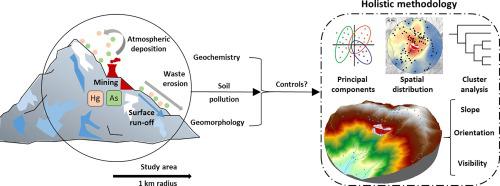Catena ( IF 5.4 ) Pub Date : 2021-09-16 , DOI: 10.1016/j.catena.2021.105730 C. Boente 1, 2 , D. Baragaño 3 , N. García-González 3 , R. Forján 3 , A. Colina 3 , J.R. Gallego 3

|
Control of Potentially Toxic Elements (PTEs) in soil-polluted areas is needed to address the potential risk that pollution poses to public health and the environment. This study describes an innovative holistic methodology to assess the distribution of PTEs. It is based on the application of multi-variate statistical and geostatistical algorithms, soil pollution indices and geochemical & geomorphological/climate variables (element concentration, watercourses, winds, slope, orientation and visibility). The methodology proposed is exemplified through a comprehensive soil sampling in an area surrounding a former As-Hg mine that presents several sources of pollutants (abandoned mining spoil heaps, metallurgical waste, old chimneys, etc.). Factor analysis identified four main pollutants of concern: Hg, As, Pb and Sb. The mobility of the most abundant PTEs, especially As, and, to a minor extent, Hg, showed a clear influence of climatic/geomorphological variables. Moreover, the pollution indices confirmed that although the soils in the areas around the spoil heaps contain higher concentrations of the pollutants, the influence of the chimneys is present in the whole study area and depends on factors such as orientation and visibility. In contrast, the fingerprint of the spoil heaps showed a PTE distribution more associated with the slope factor and the presence of watercourses eroding the heaps. All things considered, the methodology proposed revealed PTE sources and distribution in a highly complex site and may therefore find application in similar scenarios of contamination.
中文翻译:

一种研究土壤中潜在有毒元素分布的地球化学和地貌控制的整体方法
需要控制土壤污染地区的潜在有毒元素 (PTE),以解决污染对公众健康和环境造成的潜在风险。本研究描述了一种创新的整体方法来评估 PTE 的分布。它基于多变量统计和地质统计算法、土壤污染指数和地球化学和地貌/气候变量(元素浓度、水道、风、坡度、方向和能见度)的应用。提议的方法通过在前 As-Hg 矿周围区域进行全面土壤采样来举例说明,该区域存在多种污染物来源(废弃的采矿废料堆、冶金废料、旧烟囱等)。因子分析确定了四种主要的关注污染物:Hg、As、Pb 和 Sb。最丰富的 PTE,尤其是 As,以及在较小程度上,Hg 的流动性,显示出气候/地貌变量的明显影响。此外,污染指数证实,虽然弃土堆周围区域的土壤污染物浓度较高,但烟囱的影响存在于整个研究区域,并取决于方向和能见度等因素。相比之下,弃土堆的指纹显示 PTE 分布与坡度因子和侵蚀堆的水道的存在更相关。考虑到所有因素,所提出的方法揭示了高度复杂地点的 PTE 来源和分布,因此可能会在类似的污染场景中找到应用。显示出气候/地貌变量的明显影响。此外,污染指数证实,虽然弃土堆周围区域的土壤污染物浓度较高,但烟囱的影响存在于整个研究区域,并取决于方向和能见度等因素。相比之下,弃土堆的指纹显示 PTE 分布与坡度因子和侵蚀堆的水道的存在更相关。考虑到所有因素,所提出的方法揭示了高度复杂地点的 PTE 来源和分布,因此可能会在类似的污染场景中找到应用。显示出气候/地貌变量的明显影响。此外,污染指数证实,虽然弃土堆周围区域的土壤污染物浓度较高,但烟囱的影响存在于整个研究区域,并取决于方向和能见度等因素。相比之下,弃土堆的指纹显示 PTE 分布与坡度因子和侵蚀堆的水道的存在更相关。考虑到所有因素,所提出的方法揭示了高度复杂地点的 PTE 来源和分布,因此可能会在类似的污染场景中找到应用。污染指数证实,虽然弃土堆周围区域的土壤污染物浓度较高,但烟囱的影响存在于整个研究区域,并取决于方向和能见度等因素。相比之下,弃土堆的指纹显示 PTE 分布与坡度因子和侵蚀堆的水道的存在更相关。考虑到所有因素,所提出的方法揭示了高度复杂地点的 PTE 来源和分布,因此可能会在类似的污染场景中得到应用。污染指数证实,虽然弃土堆周围区域的土壤污染物浓度较高,但烟囱的影响存在于整个研究区域,并取决于方向和能见度等因素。相比之下,弃土堆的指纹显示 PTE 分布与坡度因子和侵蚀堆的水道的存在更相关。考虑到所有因素,所提出的方法揭示了高度复杂地点的 PTE 来源和分布,因此可能会在类似的污染场景中找到应用。弃土堆的指纹显示 PTE 分布与坡度因子和侵蚀堆的水道的存在更相关。考虑到所有因素,所提出的方法揭示了高度复杂地点的 PTE 来源和分布,因此可能会在类似的污染场景中找到应用。弃土堆的指纹显示 PTE 分布与坡度因子和侵蚀堆的水道的存在更相关。考虑到所有因素,所提出的方法揭示了高度复杂地点的 PTE 来源和分布,因此可能会在类似的污染场景中找到应用。











































 京公网安备 11010802027423号
京公网安备 11010802027423号